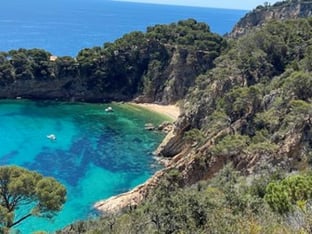Why this European retirement destination is a longstanding favourite


Sixty-year-old Paul Smith led me along a quiet country road, lined by bright sunflowers.
He accelerated his grey Basso racing bike up a short climb.
“We didn’t have climbs in Dubai,” he smiled.
“But I did enjoy cycling the Al Qudra Cycle Track.”
After 14 years in the UAE, Paul eased back on full-time work and ramped up his fitness.
Three years ago, he moved to Girona, Spain. He still consults for a US-based Risk Advisory Firm. But these days, he spends more time savouring the tastes of retirement...

Photo taken by Andrew Hallam: Paul Smith, cycling outside Girona.
That means riding his bike along some of the best cycling roads in the world. Girona is home to many top professional riders and it’s popular among cycling holiday-seekers.
It also attracts low-key tourists, enjoying the cobbled streets, cafes and restaurants in the old town quarters. That was where Paul agreed to meet me.

Photo taken by Andrew Hallam: Girona’s old town
We cycled to a restaurant at Lake of Banyoles, where we ordered a meal and a couple of drinks. “They held the rowing competitions here during the 1992 Barcelona Olympics,” he said. Looking out, I saw a couple of rowers in racing lanes. To the west, a handful of serious swimmers were getting ready for a training session.
“My grandparents and my parents retired to Spain,” said Paul, as he sipped his drink. He and his adult daughter came on a reconnaissance mission three years ago. And neither of them left.
Since then, Paul met and married his wife, Marina. “We own apartments in Girona, Barcelona and on the Costa Brava,” he says. “This fits in with the Spanish tradition of spending a lot of time at the coast during the summer months and then having a place in Barcelona to stay whilst enjoying the city at weekends.”

Photo taken by Andrew Hallam: Costa Brava
Spain offers luxury for less.
You could live well on a shoestring too. “Once you have a property to live in, the cost of utility bills, food and other essentials could be less than 1000 euros a month,” Paul smiles.
I was sceptical of the low costs that Paul spoke about in Girona. After all, I had spent a week in the old town region, and it didn’t seem cheap.
Paul laughed. “Almost everyone who visits Spain thinks like a tourist,” he said. “Once you get out of the tourist areas, the costs are really low.”
I was visiting Girona with five of my friends. Paul asked us to follow him, by bicycle, to one of his favourite places to eat. The seven of us enjoyed a 3-course meal and wine for a grand total of Є117 ($124 USD). That was just Є16 (16.97 USD) each.
 Photo courtesy of Andrew Hallam: Three-course lunch with wine, outside Girona, Є16 (16.97 USD) each.
Photo courtesy of Andrew Hallam: Three-course lunch with wine, outside Girona, Є16 (16.97 USD) each.
The economic recession from 2008–2014 hit Spain like a series of hammers. Properties that were more expensive than equivalent homes in Portugal, for example, plunged in value. And many popular regions are still priced low today. For example, property in the ocean-side city of Malaga, with its long sandy beach and its fabulous mountain backdrop costs less to rent or buy than equal-sized properties in Lisbon, Portugal.
In a previous story, I highlighted the low costs of living in Lisbon. But most Spanish cities cost less. According to Numbeo.com, Malaga’s rental prices are about 22 percent lower than Lisbon’s. To buy an equal-sized apartment in Malaga costs about 23 percent less than it does in Lisbon and about 40 percent less than it does in Cascais, Portugal.
It costs less to live in Girona than it does in Lisbon, too.
Even the iconic city of Seville, Spain, costs 25 percent less than Lisbon. Spain’s capital, Madrid, is also cheaper than Portugal’s capital city.
Spain has a varied geography and climate. The coastal areas can sizzle in the summer, making the Mediterranean seaside a vacationer’s dream. In the winter, it’s cold enough to ski in the Pyrenees near the French border. Spanish ski resorts are also cheaper than they are in France.
You can also ski in the Sierra Nevada region and near Madrid, in the northwest (including Galicia, Leon and Catabria, as well as La Rioja and Teruel).
If you’re wondering about medical facilities, Paul says it’s world-class. “I recently had a colonoscopy,” he says. “And compared to the UK, it was streets ahead, in terms of getting it done and the quality of the facilities.”
The World Health Organization ranked Spain’s medical system the 7th best in the world. Perhaps as a result of that, and the relaxed culture, Spaniards live an average of 83 years. That’s longer than the average life expectancy in most European countries, and significantly longer than people live in the United States.
“I have an individual medical policy with a company called FIATC,” says Paul. “It’s the largest in Spain, and it costs me Є1,068 per annum, with a Є90 supplement to include dental.”
Spain is also one of the safest countries in the world. According to the World Bank’s data on intentional homicides, Spain records less than one homicide per year for every 100,000 people. It’s slightly safer than Belgium, Canada and the UK.
If you’re interested in retiring or moving to Spain, consult an immigration lawyer. They can explain the different residency programs and find one that’s right for you.
Paul Smith, for his part, gushes about Spain.
But then he adds, “Just don’t tell too many people about it.”
Andrew Hallam is the best-selling author of Millionaire Expat (3rd edition), Balance, and Millionaire Teacher.

